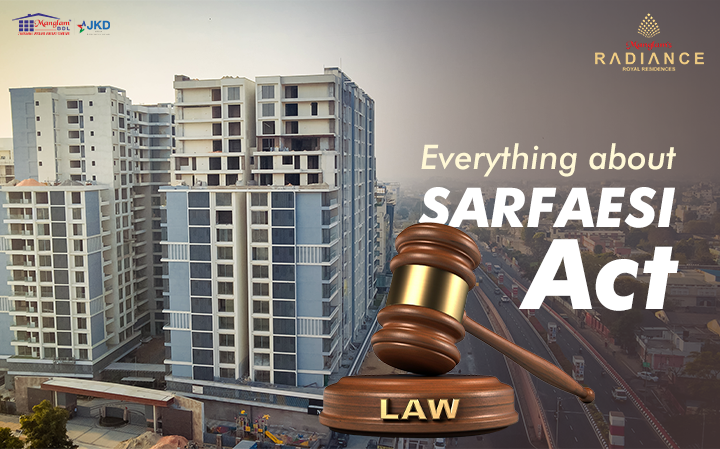In this article, you will know about The SARFAESI Act, when it was introduced by the government, It’s applicability, act procedure and many more. It was intended “to govern the securitization and reconstruction of financial assets and the enforcement of security interests and to provide for a centralized system of security interests designed on property ownership, and for matters connected therewith or incidental thereto.” Lenders have the power to retrieve their loans without the involvement of the court system because of the Sarfaesi Act.
Everything About SARFAESI ACT
One of the important players in India’s efforts to succeed in successfully accelerating its economic development has been the finance industry. Because of the financial sector changes and evolving commercial practices, our current legal system’s approach to commercial transactions has lagged. This guarantees the slow rate of defaulted loan recovery and rising non-performing asset levels of banks and financial institutions.
The Central Government established the Narasimham Committees I and II and Andhyarujina Committee to examine banking sector reforms, and these committees have taken into account the requirement for changes in the legal system concerning these sectors.
These committees have provided recommendations to the other committees about the creation of new legislation for securitization that would allow banks and financial institutions to acquire securities and sell them without the need for court intervention.
SARFAESI Full Form
According to the Securitization and Reconstruction of Financial Assets and Enforcement of Security Interest (SARFAESI Act, 2002), which gives banks in India a mechanism to significantly lower their non-performing assets (NPAs), banks have been given the right to retain the security provided by the indebted borrower against the line of credit and sell it to recover losses, without any involvement from any court of law. The statute is also referred to by its abbreviation, SARFAESI Act or just SARFAESI.
SARFAESI act 2002
To give financial institutions a safety net in the event of failures, the government created the SARFAESI Act, 2002. If the borrower defaults, the legislation permits banks to seize ownership of and auction the collateral against the loan, among other things.
The SARFAESI Act of 2002 is a law that “regulates the securitization and reconstruction of financial assets, the enforcement of security interests, and the establishment of a central database of security interests founded on property rights, as well as things incidental or connected thereto.” The SARFAESI Act 2002, which went into effect on June 22, 2002, was made applicable to the entire nation.
Applicability
The SARFAESI Act primarily offers judicial redress for issues involving:
- Companies for asset reconstruction are registered.
- Acquiring a right or interest in money-related items.
- Measures for rebuilding assets.
- The settling of conflicts.
Where is SARFAESI not applicable?
The terms of this Act apply to NPAs, or overdue loans over Rs. 1 lakh. The SARFAESI Act does not apply to:
- Any real estate covered by Section 60 of the Code of Civil Procedure from 1908 is not subject to attachment or sale.
- Any conditional sale, lease, hire-purchase, or other agreement in which no security interest has been established.
- Issued money and securities under The Indian Contract Act or the Sale of Goods Act of 1930
- Less than 20% of the principal and interest are being paid on the NPA loan.
- Any seller’s unpaid-seller rights under Section 47 of the 1930 Sale of Goods Act.
Who is eligible for SARFAESI act?
According to a notification from the Ministry of Finance dated February 24, 2020, NBFCs that have assets of at least Rs. 100 crores are eligible to pursue security interests on debts totalling at least Rs. 50 lacs and are therefore covered by the SARFAESI Act.
SARFAESI Act Procedure
Before they may seize property and use it to recoup their debt, banks must follow a set of procedures. The SARFAESI Act procedure is the framework in which they work. The SARFAESI Act gives banks the legal right to send borrowers notices asking them to pay off their debts within 60 days if they are unable to make loan payments for six months (this includes home loans). The financial institution has the power to sell the property at a distress sale if the borrower is unable to pay this obligation.
Within 30 days after the order’s passing, a person in default who feels wronged by the bank’s decision may file an appeal with the legal authority designated as the appellate body. Once the bank obtains possession of the property, it is free to sell or rent it out. Additionally, it can give another entity the right to the property. The bank’s outstanding debts are paid off first with the sale profits. If money is still available, it is given to the defaulting borrower.
Also Read:- How does the Sarfaesi Act help recover bad loans?
SARFAESI Act News Updates
Writ petition against SARFAESI-initiated procedures is not maintainable, according to the Supreme Court.
The Supreme Court declared in January 2022 that debtors who were wronged by legal actions brought under the SARFAESI Act could only file a lawsuit against that law. The supreme court determined that no writ petition would be viable in this situation. According to the SC, “no write petition would lie, be maintainable, or be entertained if proceedings under the SARFAESI Act have commenced and/or any proposed action is to be taken and the borrower is aggrieved by any of the activities of the private bank/bank/ARC.”
In its decision, the SC annulled a Karnataka High Court order that had barred an asset reconstruction business from taking back the properties of a borrower unless the former had paid the latter Rs 3 crores.
“Simply abusing the court’s process, the borrowers’ filing of a writ petition before the top court. Initially, it appears that the high court issued an ex-parte ad-interim order mechanically and without providing any justification. Even so, it must be noted that a writ petition under Article 226 of the Indian Constitution against the private financial institution, ARC, the appellant in this case, against the proposed action(s) under Section 13(4) of the SARFAESI Act can be said to be not maintainable,” the SC stated in its order, calling the HC ruling “absolutely unjustifiable.”
Click On This PDF, to learn more.
SARFAESI Act Notice Period
Fresh 30-day notice is not a must if the borrower hinders property sale under SARFAESI Act, says SC
The Supreme Court held in the S Karthik against N Subhash Chand Jain case that a new notice of 30 days is not necessary to be given to the owner if the sale of a mortgaged property under the SARFAESI Act is hampered due to an act of the borrower during the 30-day notice period.
The top court ruled that a litigant could not be permitted to halt the SARFAESI Act proceedings if he was pursuing various legal actions to obstruct the current procedure and undermine the very intent of the aforementioned law. This was stated while dismissing a special leave petition filed by the borrower.
In the case between S. Karthik and N. Subhash Chand Jain, the appellants served as the guarantors for a loan that the borrower had obtained from a bank. To recoup its losses when the borrower defaulted on the loan, the bank began the process of selling the mortgaged property. The proceedings were suspended, though, by the Chennai Debt Recovery Tribunal. But the bank did sell the property after issuing a second notice of sale. The appellants claimed in their petition that Rules 8 and 9 of the SARFAESI Act were broken by the bank’s notice of the transaction.
Remember that the sale of immovable property is prohibited under Rule 9(1) of the SARFAESI Act until 30 days have passed after the day that either a public notice of the sale was published in the newspapers or the borrower received notice of the sale. Following Subrule (6) of Rule 8, the borrower must additionally get notice of the immovable secured assets’ sale 30 days before the sale.
Click here, If you want to know about DLC rates in Rajasthan
Only 10 days were granted to the borrower by the bank in its notice of sale. The petitioners said in their argument before the Madras High Court that the sale was invalid and needed to be annulled since the second sale notice could not be regarded as a new notice but rather as a continuation of the first one. The plea was ultimately rejected by the High Court.
“Since the sale as per the initial sale notice could not be held due to the reasons attributable entirely to the guarantors, there was no necessity of again following the same procedure of delivering a 30 days’ clear notice,” the SC stated in its judgment after reaching a verdict in the case.
The SARFAESI Act was created to facilitate securitization and give banks and financial institutions the authority to seize securities and sell them without the need for court supervision. The facts of this case demonstrate that every effort has been made to undermine the SARFAESI Act’s goals, the supreme court ruled in its ruling.




